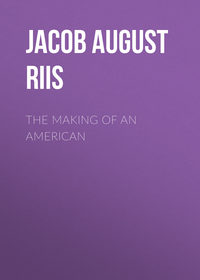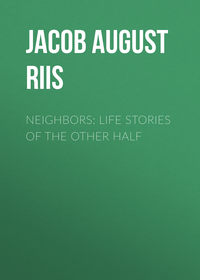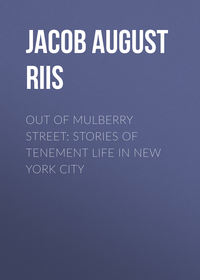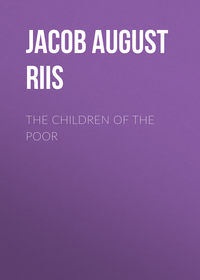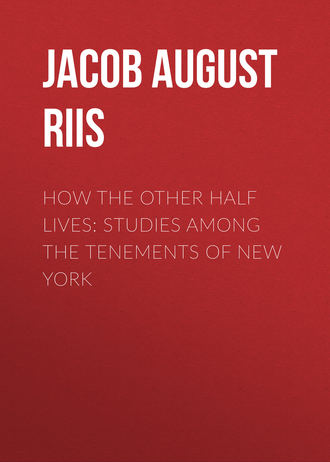 полная версия
полная версияHow the Other Half Lives: Studies Among the Tenements of New York
The determined effort to head it off by laying a strong hand upon the tenement builders that has been the chief business of the Health Board of recent years, dates from this period. The era of the air-shaft has not solved the problem of housing the poor, but it has made good use of limited opportunities. Over the new houses sanitary law exercises full control. But the old remain. They cannot be summarily torn down, though in extreme cases the authorities can order them cleared. The outrageous overcrowding, too, remains. It is characteristic of the tenements. Poverty, their badge and typical condition, invites—compels it. All efforts to abate it result only in temporary relief. As long as they exist it will exist with them. And the tenements will exist in New York forever.
To-day, what is a tenement? The law defines it as a house “occupied by three or more families, living independently and doing their cooking on the premises; or by more than two families on a floor, so living and cooking and having a common right in the halls, stairways, yards, etc.” That is the legal meaning, and includes flats and apartment-houses, with which we have nothing to do. In its narrower sense the typical tenement was thus described when last arraigned before the bar of public justice: “It is generally a brick building from four to six stories high on the street, frequently with a store on the first floor which, when used for the sale of liquor, has a side opening for the benefit of the inmates and to evade the Sunday law; four families occupy each floor, and a set of rooms consists of one or two dark closets, used as bedrooms, with a living room twelve feet by ten. The staircase is too often a dark well in the centre of the house, and no direct through ventilation is possible, each family being separated from the other by partitions. Frequently the rear of the lot is occupied by another building of three stories, high with two families on a floor.” The picture is nearly as true to-day as ten years ago, and will be for a long time to come. The dim light admitted by the air-shaft shines upon greater crowds than ever. Tenements are still “good property,” and the poverty of the poor man his destruction. A barrack down town where he has to live because he is poor brings in a third more rent than a decent flat house in Harlem. The statement once made a sensation that between seventy and eighty children had been found in one tenement. It no longer excites even passing attention, when the sanitary police report counting 101 adults and 91 children in a Crosby Street house, one of twins, built together. The children in the other, if I am not mistaken, numbered 89, a total of 180 for two tenements! Or when a midnight inspection in Mulberry Street unearths a hundred and fifty “lodgers” sleeping on filthy floors in two buildings. Spite of brown-stone trimmings, plate-glass and mosaic vestibule floors, the water does not rise in summer to the second story, while the beer flows unchecked to the all-night picnics on the roof. The saloon with the side-door and the landlord divide the prosperity of the place between them, and the tenant, in sullen submission, foots the bills.
Where are the tenements of to-day? Say rather: where are they not? In fifty years they have crept up from the Fourth Ward slums and the Five Points the whole length of the island, and have polluted the Annexed District to the Westchester line. Crowding all the lower wards, wherever business leaves a foot of ground unclaimed; strung along both rivers, like ball and chain tied to the foot of every street, and filling up Harlem with their restless, pent-up multitudes, they hold within their clutch the wealth and business of New York, hold them at their mercy in the day of mob-rule and wrath. The bullet-proof shutters, the stacks of hand-grenades, and the Gatling guns of the Sub-Treasury are tacit admissions of the fact and of the quality of the mercy expected. The tenements to-day are New York, harboring three-fourths of its population. When another generation shall have doubled the census of our city, and to that vast army of workers, held captive by poverty, the very name of home shall be as a bitter mockery, what will the harvest be?
CHAPTER III.
THE MIXED CROWD
When once I asked the agent of a notorious Fourth Ward alley how many people might be living in it I was told: One hundred and forty families, one hundred Irish, thirty-eight Italian, and two that spoke the German tongue. Barring the agent herself, there was not a native-born individual in the court. The answer was characteristic of the cosmopolitan character of lower New York, very nearly so of the whole of it, wherever it runs to alleys and courts. One may find for the asking an Italian, a German, a French, African, Spanish, Bohemian, Russian, Scandinavian, Jewish, and Chinese colony. Even the Arab, who peddles “holy earth” from the Battery as a direct importation from Jerusalem, has his exclusive preserves at the lower end of Washington Street. The one thing you shall vainly ask for in the chief city of America is a distinctively American community. There is none; certainly not among the tenements. Where have they gone to, the old inhabitants? I put the question to one who might fairly be presumed to be of the number, since I had found him sighing for the “good old days” when the legend “no Irish need apply” was familiar in the advertising columns of the newspapers. He looked at me with a puzzled air. “I don’t know,” he said. “I wish I did. Some went to California in ’49, some to the war and never came back. The rest, I expect, have gone to heaven, or somewhere. I don’t see them ’round here.”
Whatever the merit of the good man’s conjectures, his eyes did not deceive him. They are not here. In their place has come this queer conglomerate mass of heterogeneous elements, ever striving and working like whiskey and water in one glass, and with the like result: final union and a prevailing taint of whiskey. The once unwelcome Irishman has been followed in his turn by the Italian, the Russian Jew, and the Chinaman, and has himself taken a hand at opposition, quite as bitter and quite as ineffectual, against these later hordes. Wherever these have gone they have crowded him out, possessing the block, the street, the ward with their denser swarms. But the Irishman’s revenge is complete. Victorious in defeat over his recent as over his more ancient foe, the one who opposed his coming no less than the one who drove him out, he dictates to both their politics, and, secure in possession of the offices, returns the native his greeting with interest, while collecting the rents of the Italian whose house he has bought with the profits of his saloon. As a landlord he is picturesquely autocratic. An amusing instance of his methods came under my notice while writing these lines. An inspector of the Health Department found an Italian family paying a man with a Celtic name twenty-five dollars a month for three small rooms in a ramshackle rear tenement—more than twice what they were worth—and expressed his astonishment to the tenant, an ignorant Sicilian laborer. He replied that he had once asked the landlord to reduce the rent, but he would not do it.
“Well! What did he say?” asked the inspector.
“‘Damma, man!’ he said; ‘if you speaka thata way to me, I fira you and your things in the streeta.’” And the frightened Italian paid the rent.
In justice to the Irish landlord it must be said that like an apt pupil he was merely showing forth the result of the schooling he had received, re-enacting, in his own way, the scheme of the tenements. It is only his frankness that shocks. The Irishman does not naturally take kindly to tenement life, though with characteristic versatility he adapts himself to its conditions at once. It does violence, nevertheless, to the best that is in him, and for that very reason of all who come within its sphere soonest corrupts him. The result is a sediment, the product of more than a generation in the city’s slums, that, as distinguished from the larger body of his class, justly ranks at the foot of tenement dwellers, the so-called “low Irish.”
It is not to be assumed, of course, that the whole body of the population living in the tenements, of which New Yorkers are in the habit of speaking vaguely as “the poor,” or even the larger part of it, is to be classed as vicious or as poor in the sense of verging on beggary.
New York’s wage-earners have no other place to live, more is the pity. They are truly poor for having no better homes; waxing poorer in purse as the exorbitant rents to which they are tied, as ever was serf to soil, keep rising. The wonder is that they are not all corrupted, and speedily, by their surroundings. If, on the contrary, there be a steady working up, if not out of the slough, the fact is a powerful argument for the optimist’s belief that the world is, after all, growing better, not worse, and would go far toward disarming apprehension, were it not for the steadier growth of the sediment of the slums and its constant menace. Such an impulse toward better things there certainly is. The German rag-picker of thirty years ago, quite as low in the scale as his Italian successor, is the thrifty tradesman or prosperous farmer of to-day.6
The Italian scavenger of our time is fast graduating into exclusive control of the corner fruit-stands, while his black-eyed boy monopolizes the boot-blacking industry in which a few years ago he was an intruder. The Irish hod-carrier in the second generation has become a brick-layer, if not the Alderman of his ward, while the Chinese coolie is in almost exclusive possession of the laundry business. The reason is obvious. The poorest immigrant comes here with the purpose and ambition to better himself and, given half a chance, might be reasonably expected to make the most of it. To the false plea that he prefers the squalid homes in which his kind are housed there could be no better answer. The truth is, his half chance has too long been wanting, and for the bad result he has been unjustly blamed.
As emigration from east to west follows the latitude, so does the foreign influx in New York distribute itself along certain well-defined lines that waver and break only under the stronger pressure of a more gregarious race or the encroachments of inexorable business. A feeling of dependence upon mutual effort, natural to strangers in a strange land, unacquainted with its language and customs, sufficiently accounts for this.
The Irishman is the true cosmopolitan immigrant. All-pervading, he shares his lodging with perfect impartiality with the Italian, the Greek, and the “Dutchman,” yielding only to sheer force of numbers, and objects equally to them all. A map of the city, colored to designate nationalities, would show more stripes than on the skin of a zebra, and more colors than any rainbow. The city on such a map would fall into two great halves, green for the Irish prevailing in the West Side tenement districts, and blue for the Germans on the East Side. But intermingled with these ground colors would be an odd variety of tints that would give the whole the appearance of an extraordinary crazy-quilt. From down in the Sixth Ward, upon the site of the old Collect Pond that in the days of the fathers drained the hills which are no more, the red of the Italian would be seen forcing its way northward along the line of Mulberry Street to the quarter of the French purple on Bleecker Street and South Fifth Avenue, to lose itself and reappear, after a lapse of miles, in the “Little Italy” of Harlem, east of Second Avenue. Dashes of red, sharply defined, would be seen strung through the Annexed District, northward to the city line. On the West Side the red would be seen overrunning the old Africa of Thompson Street, pushing the black of the negro rapidly uptown, against querulous but unavailing protests, occupying his home, his church, his trade and all, with merciless impartiality. There is a church in Mulberry Street that has stood for two generations as a sort of milestone of these migrations. Built originally for the worship of staid New Yorkers of the “old stock,” it was engulfed by the colored tide, when the draft-riots drove the negroes out of reach of Cherry Street and the Five Points. Within the past decade the advance wave of the Italian onset reached it, and to-day the arms of United Italy adorn its front. The negroes have made a stand at several points along Seventh and Eighth Avenues; but their main body, still pursued by the Italian foe, is on the march yet, and the black mark will be found overshadowing to-day many blocks on the East Side, with One Hundredth Street as the centre, where colonies of them have settled recently.
Hardly less aggressive than the Italian, the Russian and Polish Jew, having overrun the district between Rivington and Division Streets, east of the Bowery, to the point of suffocation, is filling the tenements of the old Seventh Ward to the river front, and disputing with the Italian every foot of available space in the back alleys of Mulberry Street. The two races, differing hopelessly in much, have this in common: they carry their slums with them wherever they go, if allowed to do it. Little Italy already rivals its parent, the “Bend,” in foulness. Other nationalities that begin at the bottom make a fresh start when crowded up the ladder. Happily both are manageable, the one by rabbinical, the other by the civil law. Between the dull gray of the Jew, his favorite color, and the Italian red, would be seen squeezed in on the map a sharp streak of yellow, marking the narrow boundaries of Chinatown. Dovetailed in with the German population, the poor but thrifty Bohemian might be picked out by the sombre hue of his life as of his philosophy, struggling against heavy odds in the big human bee-hives of the East Side. Colonies of his people extend northward, with long lapses of space, from below the Cooper Institute more than three miles. The Bohemian is the only foreigner with any considerable representation in the city who counts no wealthy man of his race, none who has not to work hard for a living, or has got beyond the reach of the tenement.
Down near the Battery the West Side emerald would be soiled by a dirty stain, spreading rapidly like a splash of ink on a sheet of blotting paper, headquarters of the Arab tribe, that in a single year has swelled from the original dozen to twelve hundred, intent, every mother’s son, on trade and barter. Dots and dashes of color here and there would show where the Finnish sailors worship their djumala (God), the Greek pedlars the ancient name of their race, and the Swiss the goddess of thrift. And so on to the end of the long register, all toiling together in the galling fetters of the tenement. Were the question raised who makes the most of life thus mortgaged, who resists most stubbornly its levelling tendency—knows how to drag even the barracks upward a part of the way at least toward the ideal plane of the home—the palm must be unhesitatingly awarded the Teuton. The Italian and the poor Jew rise only by compulsion. The Chinaman does not rise at all; here, as at home, he simply remains stationary. The Irishman’s genius runs to public affairs rather than domestic life; wherever he is mustered in force the saloon is the gorgeous centre of political activity. The German struggles vainly to learn his trick; his Teutonic wit is too heavy, and the political ladder he raises from his saloon usually too short or too clumsy to reach the desired goal. The best part of his life is lived at home, and he makes himself a home independent of the surroundings, giving the lie to the saying, unhappily become a maxim of social truth, that pauperism and drunkenness naturally grow in the tenements. He makes the most of his tenement, and it should be added that whenever and as soon as he can save up money enough, he gets out and never crosses the threshold of one again.
CHAPTER IV.
THE DOWN TOWN BACK-ALLEYS
Down below Chatham Square, in the old Fourth Ward, where the cradle of the tenement stood, we shall find New York’s Other Half at home, receiving such as care to call and are not afraid. Not all of it, to be sure, there is not room for that; but a fairly representative gathering, representative of its earliest and worst traditions. There is nothing to be afraid of. In this metropolis, let it be understood, there is no public street where the stranger may not go safely by day and by night, provided he knows how to mind his own business and is sober. His coming and going will excite little interest, unless he is suspected of being a truant officer, in which case he will be impressed with the truth of the observation that the American stock is dying out for want of children. If he escapes this suspicion and the risk of trampling upon, or being himself run down by the bewildering swarms of youngsters that are everywhere or nowhere as the exigency and their quick scent of danger direct, he will see no reason for dissenting from that observation. Glimpses caught of the parents watching the youngsters play from windows or open doorways will soon convince him that the native stock is in no way involved.
Leaving the Elevated Railroad where it dives under the Brooklyn Bridge at Franklin Square, scarce a dozen steps will take us where we wish to go. With its rush and roar echoing yet in our ears, we have turned the corner from prosperity to poverty. We stand upon the domain of the tenement. In the shadow of the great stone abutments the old Knickerbocker houses linger like ghosts of a departed day. Down the winding slope of Cherry Street—proud and fashionable Cherry Hill that was—their broad steps, sloping roofs, and dormer windows are easily made out; all the more easily for the contrast with the ugly barracks that elbow them right and left. These never had other design than to shelter, at as little outlay as possible, the greatest crowds out of which rent could be wrung. They were the bad after-thought of a heedless day. The years have brought to the old houses unhonored age, a querulous second childhood that is out of tune with the time, their tenants, the neighbors, and cries out against them and against you in fretful protest in every step on their rotten floors or squeaky stairs. Good cause have they for their fretting. This one, with its shabby front and poorly patched roof, what glowing firesides, what happy children may it once have owned? Heavy feet, too often with unsteady step, for the pot-house is next door—where is it not next door in these slums?—have worn away the brown-stone steps since; the broken columns at the door have rotted away at the base. Of the handsome cornice barely a trace is left. Dirt and desolation reign in the wide hallway, and danger lurks on the stairs. Rough pine boards fence off the roomy fire-places—where coal is bought by the pail at the rate of twelve dollars a ton these have no place. The arched gateway leads no longer to a shady bower on the banks of the rushing stream, inviting to day-dreams with its gentle repose, but to a dark and nameless alley, shut in by high brick walls, cheerless as the lives of those they shelter. The wolf knocks loudly at the gate in the troubled dreams that come to this alley, echoes of the day’s cares. A horde of dirty children play about the dripping hydrant, the only thing in the alley that thinks enough of its chance to make the most of it: it is the best it can do. These are the children of the tenements, the growing generation of the slums; this their home. From the great highway overhead, along which throbs the life-tide of two great cities, one might drop a pebble into half a dozen such alleys.
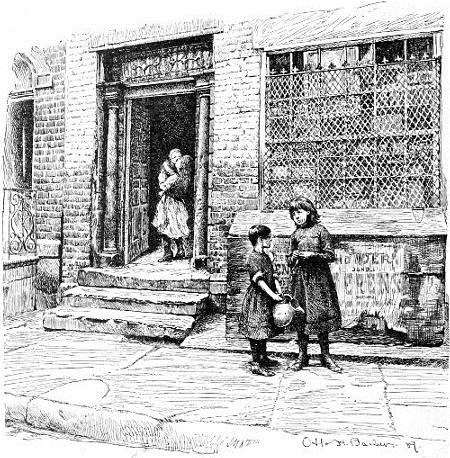
AT THE CRADLE OF THE TENEMENT.—DOORWAY OF AN OLD-FASHIONED DWELLING ON CHERRY HILL.
One yawns just across the street; not very broadly, but it is not to blame. The builder of the old gateway had no thought of its ever becoming a public thoroughfare. Once inside it widens, but only to make room for a big box-like building with the worn and greasy look of the slum tenement that is stamped alike on the houses and their tenants down here, even on the homeless cur that romps with the children in yonder building lot, with an air of expectant interest plainly betraying the forlorn hope that at some stage of the game a meat-bone may show up in the role of “It.” Vain hope, truly! Nothing more appetizing than a bare-legged ragamuffin appears. Meat-bones, not long since picked clean, are as scarce in Blind Man’s Alley as elbow-room in any Fourth Ward back-yard. The shouts of the children come hushed over the house-tops, as if apologizing for the intrusion. Few glad noises make this old alley ring. Morning and evening it echoes with the gentle, groping tap of the blind man’s staff as he feels his way to the street. Blind Man’s Alley bears its name for a reason. Until little more than a year ago its dark burrows harbored a colony of blind beggars, tenants of a blind landlord, old Daniel Murphy, whom every child in the ward knows, if he never heard of the President of the United States. “Old Dan” made a big fortune—he told me once four hundred thousand dollars—out of his alley and the surrounding tenements, only to grow blind himself in extreme old age, sharing in the end the chief hardship of the wretched beings whose lot he had stubbornly refused to better that he might increase his wealth. Even when the Board of Health at last compelled him to repair and clean up the worst of the old buildings, under threat of driving out the tenants and locking the doors behind them, the work was accomplished against the old man’s angry protests. He appeared in person before the Board to argue his case, and his argument was characteristic.
“I have made my will,” he said. “My monument stands waiting for me in Calvary. I stand on the very brink of the grave, blind and helpless, and now (here the pathos of the appeal was swept under in a burst of angry indignation) do you want me to build and get skinned, skinned? These people are not fit to live in a nice house. Let them go where they can, and let my house stand.”
In spite of the genuine anguish of the appeal, it was downright amusing to find that his anger was provoked less by the anticipated waste of luxury on his tenants than by distrust of his own kind, the builder. He knew intuitively what to expect. The result showed that Mr. Murphy had gauged his tenants correctly. The cleaning up process apparently destroyed the home-feeling of the alley; many of the blind people moved away and did not return. Some remained, however, and the name has clung to the place.
Some idea of what is meant by a sanitary “cleaning up” in these slums may be gained from the account of a mishap I met with once, in taking a flash-light picture of a group of blind beggars in one of the tenements down here. With unpractised hands I managed to set fire to the house. When the blinding effect of the flash had passed away and I could see once more, I discovered that a lot of paper and rags that hung on the wall were ablaze. There were six of us, five blind men and women who knew nothing of their danger, and myself, in an attic room with a dozen crooked, rickety stairs between us and the street, and as many households as helpless as the one whose guest I was all about us. The thought: how were they ever to be got out? made my blood run cold as I saw the flames creeping up the wall, and my first impulse was to bolt for the street and shout for help. The next was to smother the fire myself, and I did, with a vast deal of trouble. Afterward, when I came down to the street I told a friendly policeman of my trouble. For some reason he thought it rather a good joke, and laughed immoderately at my concern lest even then sparks should be burrowing in the rotten wall that might yet break out in flame and destroy the house with all that were in it. He told me why, when he found time to draw breath. “Why, don’t you know,” he said, “that house is the Dirty Spoon? It caught fire six times last winter, but it wouldn’t burn. The dirt was so thick on the walls, it smothered the fire!” Which, if true, shows that water and dirt, not usually held to be harmonious elements, work together for the good of those who insure houses.
Sunless and joyless though it be, Blind Man’s Alley has that which its compeers of the slums vainly yearn for. It has a pay-day. Once a year sunlight shines into the lives of its forlorn crew, past and present. In June, when the Superintendent of Out-door Poor distributes the twenty thousand dollars annually allowed the poor blind by the city, in half-hearted recognition of its failure to otherwise provide for them, Blindman’s Alley takes a day off and goes to “see” Mr. Blake. That night it is noisy with unwonted merriment. There is scraping of squeaky fiddles in the dark rooms, and cracked old voices sing long-forgotten songs. Even the blind landlord rejoices, for much of the money goes into his coffers.



